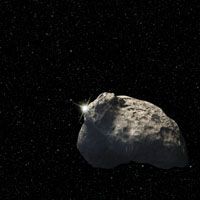Space seed
American researchers say that they have found strong evidence to support the possibility of the seeds of life being brought to Earth by meteorites.

American researchers say that they have found strong evidence to support the possibility of the seeds of life being brought to Earth by meteorites. Carbonaceous chondrites are meteorites that contain abundant organic molecules produced in space, and these rocks have been pelting the Earth since it formed. The carbonaceous meteorites of the Renazzo-type family are particularly enriched in small soluble organic molecules, such as the amino acids glycine and alanine, but it is thought that nitrogen would also need to be present for life to evolve. Analysing the insoluble and largest organic component of an Antarctic meteorite has now revealed that some do indeed contain nitrogen-based compounds.1
The compounds were mixed in with other compounds and are volatile in some conditions, so gas chromatography, mass spectrometry and solid-state nuclear magnetic resonance were used to carefully analyse the samples after they had been boiled and dissolved in acids. Ammonia was found, which the researchers say appear to have been formed in cosmochemical regimes, and delivered to Earth via these meteorites. They do speculate that this delivery could have fostered early molecular evolution, but stress that large amounts will need to be confirmed in other carbonaceous meteorites before the theory can be backed up.
1. S. Pizzarello et al., PNAS, published on-line (2011).
This story originally appeared in The Column. Click here to view that issue.

.png&w=3840&q=75)

.png&w=3840&q=75)



.png&w=3840&q=75)



.png&w=3840&q=75)










